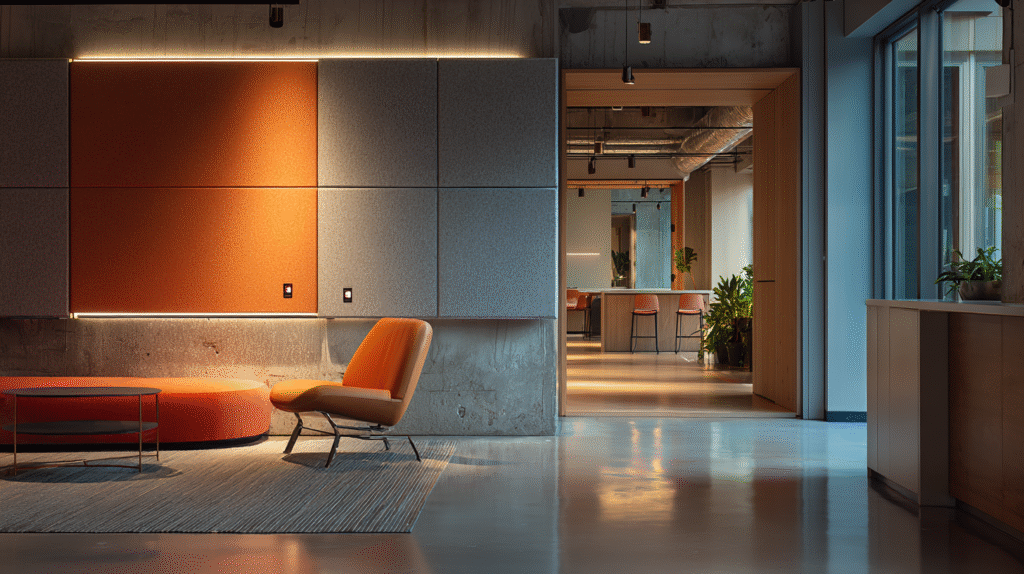

The way we design and experience buildings is changing faster than ever. Smart technologies are no longer futuristic concepts — they’re part of our daily surroundings. From climate control that adjusts to your body temperature to lighting that follows your natural rhythm, modern buildings are becoming living ecosystems that adapt to human needs. Comfort, energy efficiency, and intelligence now go hand in hand.
One of the most overlooked aspects of this transformation is sound. Noise levels directly affect how people think, work, and feel inside these intelligent spaces. Architects and engineers have started to realize that managing sound is just as crucial as controlling temperature or lighting. That’s why soundproofing panels have become a vital part of smart building systems, working in sync with IoT sensors and automation to create perfectly balanced acoustic environments.
The Rise of Intelligent Building Systems
The idea of a “smart building” is built around one goal: to make spaces responsive. Every part of the environment — lighting, heating, air quality, even sound — reacts to human presence and environmental data. This fusion of engineering and digital intelligence is redefining architecture itself.
What Makes a Building Smart
At the heart of smart buildings are interconnected systems powered by IoT sensors. These tiny devices gather data about everything: temperature, humidity, motion, CO₂ levels, and energy use. The collected information feeds into automation systems that adjust conditions in real time.
The results are buildings that learn and adapt. They minimize wasted energy, improve indoor comfort, and reduce environmental impact. Smart windows tint automatically, HVAC systems respond to occupancy, and lights dim when natural sunlight floods the room. All of this makes living and working spaces more sustainable — and far more human-centered.
The Role of Acoustic Management
Sound is the next big frontier in building intelligence. As open office layouts and mixed-use environments become more common, noise has emerged as a serious design challenge. Acoustic management goes beyond quieting a space — it’s about creating balance. The right sound environment supports focus, reduces stress, and enhances overall well-being.
Poor acoustics lead to fatigue, lower productivity, and even health problems. On the other hand, well-managed soundscapes can boost concentration, promote calmness, and make interactions more pleasant. That’s why architects and engineers are now integrating acoustic modeling and smart sound control into early design stages, not as an afterthought but as a core part of building performance.
Advanced Soundproofing Technologies
As buildings get smarter, so do their walls, floors, and ceilings. Soundproofing is no longer limited to heavy insulation materials. It’s now an advanced field combining material science, digital technology, and environmental design.
Modern Materials and Engineering
The latest generation of soundproofing materials uses complex microstructures and layered composites that absorb, diffuse, or block sound waves. Innovations like nanofiber membranes and viscoelastic polymers offer lightweight solutions with incredible performance.
There’s also a growing push toward sustainability. Manufacturers are developing acoustic panels from recycled fabrics, biodegradable foams, and natural fibers such as hemp or bamboo. These materials don’t just reduce noise — they also align with green building certifications like LEED and WELL.
Acoustic engineers now design walls with dual purposes: controlling noise while improving thermal efficiency. It’s a subtle but powerful shift — soundproofing is no longer an add-on; it’s a key component of environmental design.
Active Noise Control Systems
While traditional soundproofing relies on absorbing or blocking noise, active systems take a completely different approach. They use technology to cancel unwanted sounds in real time. Built-in microphones capture ambient noise, process it through digital algorithms, and then emit inverted sound waves that neutralize it. The result is a quieter, more controlled environment — not through mass or density, but through precision.
These systems are already being used in modern offices, hotels, and hospitals. When integrated into smart building platforms, they can automatically adapt to changing noise levels throughout the day. For instance, a workspace can stay calm during peak hours or reduce hum from HVAC systems without any human intervention. This kind of dynamic sound management defines the future of acoustic design.
IoT Integration for Acoustic Optimization
As the Internet of Things expands, it’s changing how we monitor and control sound. Smart buildings now include acoustic sensors that work just like temperature or air-quality monitors — constantly measuring noise levels and sending data to centralized systems. This information allows for real-time sound adjustments, turning static walls and ceilings into responsive sound ecosystems.
Smart Sensors and Real-Time Monitoring
Acoustic sensors don’t just record volume; they analyze sound patterns. They can distinguish between human voices, mechanical noise, or environmental sounds like traffic. When the system detects a problem — say, rising noise in a shared workspace — it can trigger an automated response: lowering background music, activating active noise control, or sending alerts to building managers.
This level of automation ensures that sound environments remain stable without requiring manual fine-tuning. It’s a blend of comfort and intelligence that reflects how deeply technology is now woven into architecture.
Data-Driven Acoustic Design
Machine learning is taking acoustic management one step further. By analyzing large sets of sound data, smart systems can predict when and where noise problems are likely to occur. That means preventive action instead of reactive fixes.
For example, predictive maintenance algorithms can identify failing ventilation systems or noisy elevators before they become disruptive. AI-based acoustic modeling tools can simulate how sound travels through a building even before it’s constructed, allowing architects to design spaces that sound as good as they look.
Applications Across Industries
The demand for better sound environments spans every type of building — from offices to hospitals to homes. Each setting has its own challenges and priorities, but all share the same goal: creating spaces that support human well-being and focus.
Corporate and Coworking Spaces
Open offices may look modern, but they often suffer from poor acoustics. Conversations, phone calls, and background chatter blur together, making concentration difficult. Smart sound zoning solves this by adapting the sound profile of each area. Meeting rooms stay quiet and private, while collaborative zones maintain an energetic but balanced atmosphere.
Flexible sound management allows companies to maintain both openness and comfort — something traditional offices could never achieve without technology.
Healthcare and Research Facilities
In hospitals and laboratories, noise is more than a distraction — it’s a potential hazard. High noise levels can interfere with sensitive equipment or delay patient recovery. Smart acoustic systems monitor decibel levels, isolate vibration sources, and even adjust airflow systems to minimize mechanical sound.
These spaces depend on absolute precision, and advanced soundproofing ensures that care and research happen in calm, controlled environments where focus and safety come first.
Residential Smart Buildings
Modern living is getting smarter and denser. Apartment complexes and condos rely on acoustic automation to maintain privacy and comfort. Smart walls can react to changing activity, adjusting their sound absorption based on occupancy or time of day.
Homeowners can even control their acoustic environment through mobile apps — choosing “quiet mode” for late evenings or activating enhanced noise reduction during home office hours. It’s personal sound design powered by technology.
Acoustic management has evolved far beyond simple insulation. Today, it’s a data-driven science that merges architecture, engineering, and artificial intelligence. Smart buildings use sound not just to block noise, but to shape experience — creating spaces that listen, adapt, and respond to the people inside them. This is the new era of design, where silence is not the absence of sound, but the presence of control.
Leave a Reply